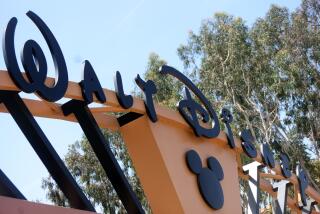Disney Plans Big Cuts in Feature Animation
- Share via
Faced with shrinking profit in one of its cornerstone businesses, Walt Disney Co. is planning to significantly scale back its feature animation operation, cutting scores of jobs and slashing salaries by 30% to 50%.
In the last two weeks, Disney executives have held two key meetings with department heads, animation supervisors and directors at the Burbank animation facility, using dramatic charts and graphs to illustrate the unit’s declining profit and hammer home the point that labor and production costs are too high.
“It’s a bad time at the mouse factory,” said a top animation source at Disney who was present at the meetings. “It’s very, very depressing, and there’s a pall hanging over this department right now.”
Steve Hulett, business agent for Motion Picture Screen Cartoonists Local 839, said, “They’re not fingering anybody at this point. But they’re saying: ‘Here it comes. The tsunami is coming.’ ”
It’s unclear how many jobs will be affected by the retrenchment, but Tom Sito, president of the local and a former Disney animator, estimated that as many as 300 positions out of more than 1,000 in Burbank could be lost. He cautioned that he has no specific information from Disney.
Disney President Robert Iger said Monday that all Disney units, including animation, are being asked to come up with “efficiencies” to better manage profitability. Among the areas under review are staffing and compensation levels as well as marketing and production expenses.
Iger denied that the animation division is retrenching, saying it has “a full slate of films planned through 2006.”
Iger wouldn’t comment on pay cuts, but said the competition for animators that drove salaries a few years ago has dissipated.
Animation is a business, Iger said, that “we remain committed to and excited about. The opportunities are growing.”
Disney already is cutting 4,000 jobs companywide, some of which are expected to be in animation, as it tries amid a softening economy to boost profit and appease Wall Street investors frustratedthat the company’s stock price continues to lag.
But the latest move strikes at the company’s heart and soul. Walt Disney launched the studio with animation in 1923, and it was animation that led Disney’s revival under Chief Executive Michael Eisner in the late 1980s and early 1990s, when the company released such hits as “Beauty and the Beast,” “Aladdin” and its high-water mark, “The Lion King.”
Although Disney has enjoyed some success since then in animation, notably with “Tarzan,” its traditional animated films have become much more expensive to make and have failed to spark the sales of videos, backpacks, figurines and other items that made the earlier films so lucrative.
Disney animation chief Tom Schumacher, who declined to be interviewed, told his department heads that when current contracts expire, everybody will be required to take pay cuts of 30% to 50%, sources said.
Union leader Sito said journeyman animators saw their salaries soar from $1,500 a week to nearly $3,000 as a result of the bidding war, with some making as much as $5,000 a week. A few superstar animators are in the $1-million-a-year range. By asking for the cuts, he said, Disney is asking animators to accept almost pre-boom pay levels. A Disney source who attended the meeting recalled that Schumacher said he personally is going to take a pay cut, though he didn’t specify how much.
The number of animation employees affected in Disney’s main animation facility in Burbank is unclear. Disney executives declined to say how many people work in Burbank and at their facilities in Orlando, Fla., and Paris. Recently, the worldwide figure has hovered at about 2,000.
Disney’s retrenchment is a far cry from the industrywide animation boom the studio sparked with the success of “The Lion King” in 1994. That film, which has generated more than $1 billion in profit for the company, prompted other studios to launch major traditional animation units. Most of those efforts were unsuccessful.
Demand for animators led to soaring salaries. Disney increasingly employed animators on a full-time basis to keep them from jumping ship, rather than employ them as independent contractors. Although giants such as Warner Bros. and 20th Century Fox entered the animation fray, Disney felt the most heat from DreamWorks SKG, where former Disney Studios chief Jeffrey Katzenberg aggressively courted Disney animators to join the studio he founded with Steven Spielberg and David Geffen in 1994.
“After Jeffrey left and the animation market went crazy, we all got huge raises,” said a top Disney animator. “We all reaped the benefits, and now we have to make cuts.” The source suggested that instead of focusing on costs, Disney management and animators should be analyzing “why these films aren’t loved by audiences anymore. What we have to do is make great films--that always pays off in the end.”
Disney lately has been favoring lower-cost animated films with the potential to generate bigger profits. In one meeting, executives pointed out that the studio’s most profitable recent animated film has been “The Tigger Movie,” a low-cost Winnie the Pooh feature. According to Paul Kagan Associates, the film cost $6.5 million to make, grossed $45.5 million domestically and $28.3 million internationally and has generated $78.8 million in video revenue.
Disney already has told its 300 or so animation artists in its Orlandothat their salaries will be slashed by 30%, union officials said. No layoffs are expected there.
But in Burbank, Disney’s 71 animators were told last week that only 38 of them would survive the cutbacks after the completion of the studio’s production of “Treasure Planet”--a Space Age version of the classic “Treasure Island.” In addition, dozens of support staff artists and personnel are expected to lose their jobs by year’s end.
Business agent Hulett said was told by Disney animators that cuts will be 15% to 20% in some departments to as much as 60% in others. Hulett said that in addition to the 33 animators being cut, more than 30 of the 127 workers who clean up animation will be cut, along with 23 of the 41 layout artists who draw background environments in animation scenes.
The retrenchment reflects a major slowdown in animation work at the studio, which recently completed its summer release, “Atlantis,” debuting nationwide June 15.
After “Treasure Planet” wraps in early winter, Disney plans to return to producing one traditional, hand-drawn animated feature at a time.
It will, however, continue to release at least two or more animated movies a year, thanks to computer-generated features from Pixar Animation Studios, the Northern California-based company behind the hit “Toy Story” films and “A Bug’s Life,” and Disney’s own 3-D animation unit near the Burbank Airport.
A small percentage of the animation crew working on “Treasure Planet” will be eligible to work on Disney’s next traditional animated production, “Sweating Bullets.” And some may be assigned to the studio’s planned live-action feature “Enchanted,” which requires about 10 minutes of animation, if that movie is given the green light, sources said.
Disney says that because of rising costs, it can’t make a profit from movies grossing $100 million at the box office.
In one of the meetings with animators, it was pointed out that the last traditional Disney movie to really strike it rich both at the box office and in all the ancillary markets, including videocassette sales and merchandising, was the studio’s 1995 release “Pocahontas.”
Although “Tarzan” was successful, it cost more than $150 million--more than “Pocahontas.”
Disney may be trying to hold down production costs, but sources say “Treasure Planet” and “Sweating Bullets” will each cost more than $100 million.
*
Times staff writer Richard Verrier in Orlando contributed to this report.
More to Read
The biggest entertainment stories
Get our big stories about Hollywood, film, television, music, arts, culture and more right in your inbox as soon as they publish.
You may occasionally receive promotional content from the Los Angeles Times.










